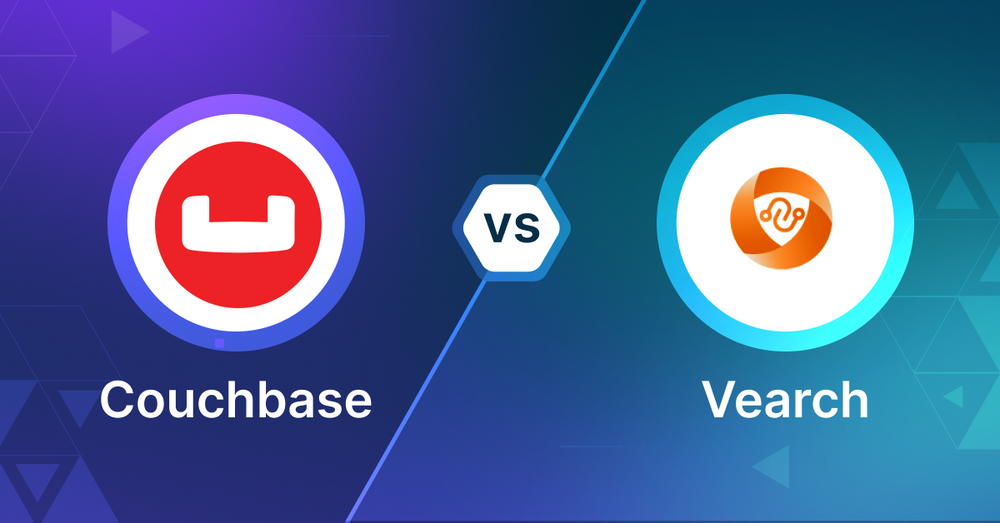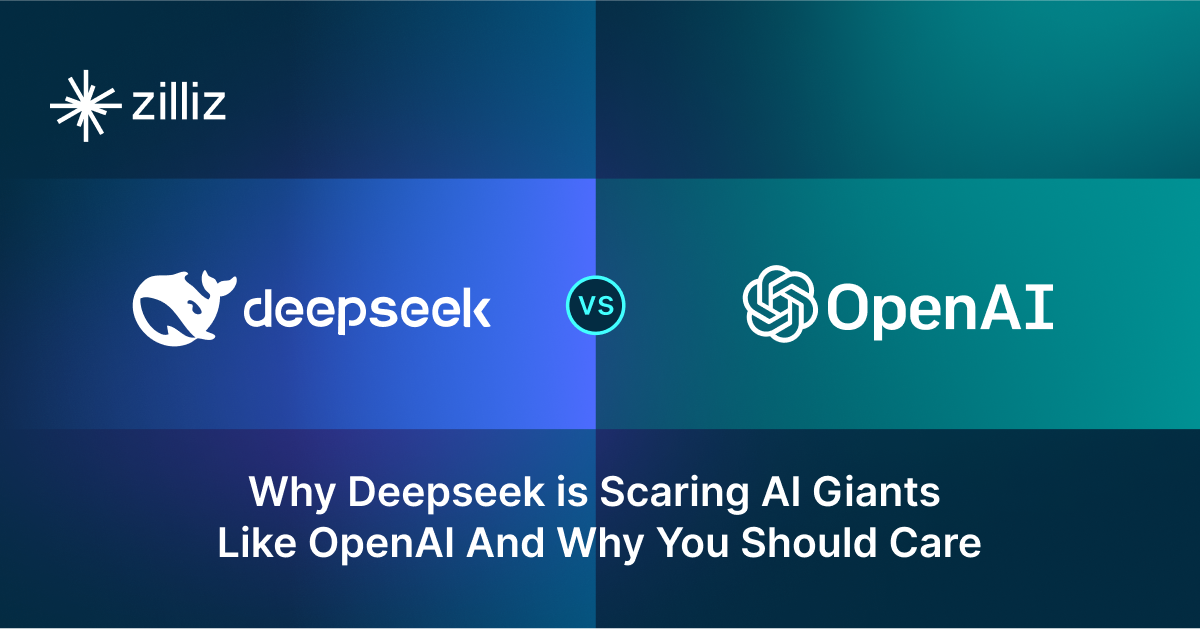Couchbase vs Vearch: Choosing the Right Vector Database for Your AI Apps

What is a Vector Database?
Before we compare Couchbase and Vearch, let's first explore the concept of vector databases.
A vector database is specifically designed to store and query high-dimensional vectors, which are numerical representations of unstructured data. These vectors encode complex information, such as the semantic meaning of text, the visual features of images, or product attributes. By enabling efficient similarity searches, vector databases play a pivotal role in AI applications, allowing for more advanced data analysis and retrieval.
Common use cases for vector databases include e-commerce product recommendations, content discovery platforms, anomaly detection in cybersecurity, medical image analysis, and natural language processing (NLP) tasks. They also play a crucial role in Retrieval Augmented Generation (RAG), a technique that enhances the performance of large language models (LLMs) by providing external knowledge to reduce issues like AI hallucinations.
There are many types of vector databases available in the market, including:
- Purpose-built vector databases such as Milvus, Zilliz Cloud (fully managed Milvus)
- Vector search libraries such as Faiss and Annoy.
- Lightweight vector databases such as Chroma and Milvus Lite.
- Traditional databases with vector search add-ons capable of performing small-scale vector searches.
Couchbase is distributed multi-model NoSQL document-oriented database with vector search capabilities as an add-on and Vearch is a purpose-built vector database. This post compares their vector search capabilities.
What is Couchbase? An Overview
Couchbase is a distributed, open source NoSQL database for cloud, mobile, AI and edge computing. It combines the best of relational databases with the flexibility of JSON. Couchbase also allows you to do vector search even though it doesn’t have native vector indexes. Developers can store vector embeddings—numerical representations generated by machine learning models—within Couchbase documents as part of their JSON structure. These vectors can be used in similarity search use cases such as recommendation systems or retrieval-augmented generation both based on semantic search where finding data points close to each other in a high dimensional space is important.
One way to do vector search in Couchbase is by using Full Text Search (FTS). FTS is designed for text search but can be used for vector search by converting vector data into searchable fields. For example, vectors can be tokenized into text-like data and FTS can index and search based on those tokens. This will give you approximate vector search and a way to query documents with vectors that are close in similarity.
Alternatively developers can store the raw vector embeddings in Couchbase and do the vector similarity calculations at the application level. This means retrieving documents and computing metrics such as cosine similarity or Euclidean distance between vectors to find the closest matches. This way Couchbase will be used as storage for vectors and the application will handle the math.
For more advanced use cases some developers integrate Couchbase with specialized libraries or algorithms that enable vector search. These integrations allow Couchbase to manage the document store and the external libraries will do the actual vector comparisons. This way Couchbase can still be part of a solution that does vector search.
By using these approaches Couchbase can be used for vector search functionality and be a flexible option for various AI and machine learning use cases that require similarity search.
What is Vearch? An Overview
Vearch is a tool for developers building AI applications that need fast and efficient similarity searches. It’s like a supercharged database, but instead of storing regular data, it’s built to handle those tricky vector embeddings that power a lot of modern AI tech.
One of the coolest things about Vearch is its hybrid search. You can search by vectors (think finding similar images or text) and also filter by regular data like numbers or text. So you can do complex searches like “find products like this one, but only in the electronics category and under $500”. It’s fast too - we’re talking searching on a corpus of millions of vectors in milliseconds.
Vearch is designed to grow with your needs. It uses a cluster setup, like a team of computers working together. You have different types of nodes (master, router and partition server) that handle different jobs, from managing metadata to storing and computing data. This allows Vearch to scale out and be reliable as your data grows. You can add more machines to handle more data or traffic without breaking a sweat.
For developers, Vearch has some nice features that make life easier. You can add data to your index in real-time so your search results are always up-to-date. It supports multiple vector fields in a single document which is handy for complex data. There’s also a Python SDK for quick development and testing. Vearch is flexible with indexing methods (IVFPQ and HNSW) and supports both CPU and GPU versions so you can optimise for your specific hardware and use case. Whether you’re building a recommendation system, similar image search or any AI app that needs fast similarity matching, Vearch gives you the tools to make it happen efficiently.
Key Differences
When choosing between Couchbase and Vearch for vector search, several factors come into play. Let's compare these technologies to help you make an informed decision.
Search Methodology:
Couchbase doesn't have native vector indexes but offers workarounds for vector search. It uses Full Text Search (FTS) by converting vector data into searchable fields. Alternatively, you can store raw vector embeddings and perform similarity calculations at the application level. Vearch, on the other hand, is purpose-built for vector search. It uses specialized indexing methods like IVFPQ and HNSW, optimized for fast similarity searches on large vector datasets.
Data Handling:
Couchbase excels in handling structured and semi-structured data, combining features of relational databases with JSON flexibility. It stores vector embeddings within JSON documents. Vearch focuses on vector data but also supports hybrid searches, combining vector similarity with traditional data filtering.
Scalability and Performance:
Both systems offer scalable solutions. Couchbase uses a distributed architecture that can handle large datasets efficiently. Vearch employs a cluster setup with different node types (master, router, partition server) to manage growth and maintain performance as data volume increases.
Flexibility and Customization:
Couchbase provides flexibility in data modeling and queries, leveraging its JSON structure. For vector search, it allows custom integrations with external libraries. Vearch offers built-in vector search capabilities with options to customize indexing methods and support for multiple vector fields in a single document.
Integration and Ecosystem:
Couchbase has a broader ecosystem, integrating well with various data processing and analytics tools. Vearch, while more specialized, offers a Python SDK for easy development and testing, and supports both CPU and GPU versions for hardware optimization.
Ease of Use:
Couchbase might have a steeper learning curve for vector search due to its workaround approaches. Vearch, designed specifically for vector search, might be more straightforward for this use case, with real-time indexing and built-in vector operations.
Cost Considerations:
Couchbase offers both open-source and enterprise editions, with various pricing models. Vearch is also open-source, potentially reducing direct software costs, but consider the infrastructure requirements for both systems.
When to Use Couchbase:
Couchbase is a good fit for projects that need a flexible, distributed NoSQL database with vector search. It’s great for apps that handle multiple data types, structured to semi-structured and need strong consistency and high availability. Use Couchbase when you need a mature database that can support vector search along with traditional data operations in complex enterprise apps, content management systems or large web apps with AI features. It’s especially useful when you want to leverage the broad ecosystem of integrations and have the flexibility to build custom vector search solutions.
When to Use Vearch:
Use Vearch when your main focus is on building AI driven apps that heavily rely on fast and efficient vector similarity searches. It’s the better choice for projects like image recognition systems, recommendation engines or natural language processing apps where vector search is the core of the functionality. Use Vearch when you need to do hybrid searches combining vector similarity with traditional data filtering, especially at scale. It’s also a good fit when you need real-time indexing of vector data and want to use GPU acceleration for search.
Conclusion:
Couchbase is good for being a general purpose NoSQL database with vector search, with a mature ecosystem and flexibility for many use cases. Its strengths are in handling multiple data types, strong consistency and many integrations. Vearch is good for specialized vector search, high performance similarity searches and hybrid queries for AI apps. The choice between these two should be based on your use case, data types and performance requirements. If you need a robust all purpose database with vector search as an add-on feature, Couchbase might be the way to go. But if your app’s core functionality is around vector similarity searches and you need performance in that area, Vearch might be the better choice. Consider your long term scalability, how important vector search is in your app and your team’s expertise when making your decision.
While this article provides an overview of Couchbase and Vearch, it's key to evaluate these databases based on your specific use case. One tool that can assist in this process is VectorDBBench, an open-source benchmarking tool designed for comparing vector database performance. Ultimately, thorough benchmarking with specific datasets and query patterns will be essential in making an informed decision between these two powerful, yet distinct, approaches to vector search in distributed database systems.
Using Open-source VectorDBBench to Evaluate and Compare Vector Databases on Your Own
VectorDBBench is an open-source benchmarking tool designed for users who require high-performance data storage and retrieval systems, particularly vector databases. This tool allows users to test and compare the performance of different vector database systems such as Milvus and Zilliz Cloud (the managed Milvus) using their own datasets and determine the most suitable one for their use cases. Using VectorDBBench, users can make informed decisions based on the actual vector database performance rather than relying on marketing claims or anecdotal evidence.
VectorDBBench is written in Python and licensed under the MIT open-source license, meaning anyone can freely use, modify, and distribute it. The tool is actively maintained by a community of developers committed to improving its features and performance.
Download VectorDBBench from its GitHub repository to reproduce our benchmark results or obtain performance results on your own datasets.
Take a quick look at the performance of mainstream vector databases on the VectorDBBench Leaderboard.
Read the following blogs to learn more about vector database evaluation.
Further Resources about VectorDB, GenAI, and ML
- What is a Vector Database?
- What is Couchbase**? An Overview**
- What is Vearch**? An Overview**
- Key Differences
- When to Use Couchbase:
- When to Use Vearch:
- Conclusion:
- Using Open-source VectorDBBench to Evaluate and Compare Vector Databases on Your Own
- Further Resources about VectorDB, GenAI, and ML
Content
Start Free, Scale Easily
Try the fully-managed vector database built for your GenAI applications.
Try Zilliz Cloud for FreeKeep Reading

Why Deepseek is Waking up AI Giants Like OpenAI And Why You Should Care
Discover how DeepSeek R1's open-source AI model with superior reasoning capabilities and lower costs is disrupting the AI landscape and challenging tech giants like OpenAI.

Long List of Awesome DeepSeek Integrations You Should Know
Discover how DeepSeek's affordable AI ecosystem challenges Silicon Valley giants with powerful integrations for developers and businesses—from RAG systems to productivity tools, all at 90% lower cost.

The AI Revolution in Marketing: How Vector Databases Are Unlocking True Personalization
Explore how vector databases and AI are transforming marketing platforms, enabling real-time personalization and predictive analytics while balancing automation with creativity.
The Definitive Guide to Choosing a Vector Database
Overwhelmed by all the options? Learn key features to look for & how to evaluate with your own data. Choose with confidence.